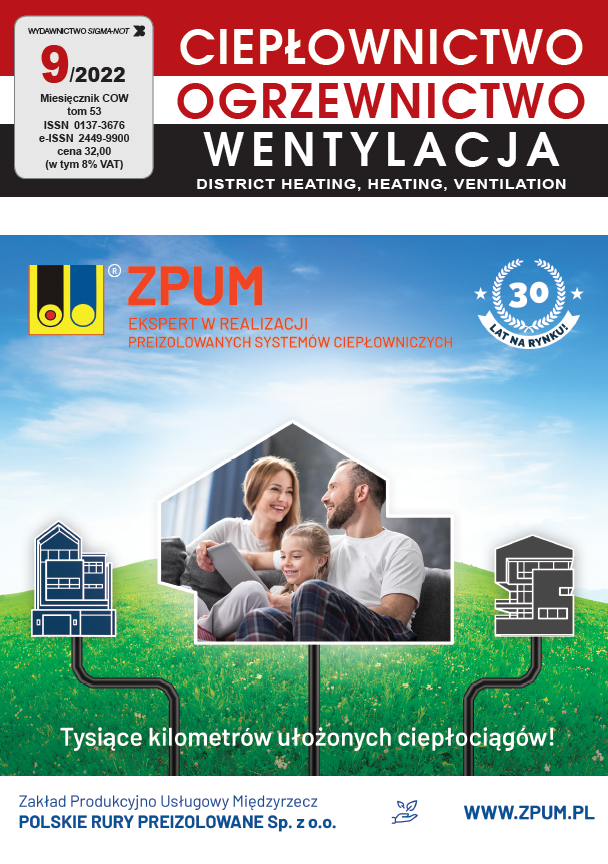HEATING, DISCTRIC-HEATING
➔ Piotr Narowski4: TLM2000 – Typical Meteorological Years for Poland, Determined on the Basis of Meteorological and Climatic Data from 2001 to 2020
DOI: 10.15199/9.2022.9.1
Keywords: typical meteorological years, meteorologic synoptic data, climate data, ERA5 reanalysis, building energy simulations
Abstract
The article presents the results of works related to the determination of new typical meteorological years for Poland, calculated on the basis of the available meteorological data of the synoptic stations of the Institute of Meteorology and Water Management and reanalysis of the ERA5 database of the Copernicus system covering the years 2001-2020. Typical meteorological years currently used in Poland for energy analyzes of buildings were developed in 2004 on the basis of meteorological data from the Institute of Meteorology and Water Management for the years 1971-2000. Source data used at that time to determine typical meteorological years for Poland included several basic 3-hour meteorological parameters and modeled values of solar radiation intensity derived from an undescribed mathematical model. The courses of values in typical meteorological years developed in 2004 were subject to many criticisms, in particular the value of the intensity of solar radiation. Bearing in mind the above critical analyzes and taking into account the observable climate changes, it should be concluded that the typical meteorological years for Poland, designated 18 years ago, have become obsolete. The article describes the data sources and the method of determining new typical meteorological years for Poland ‒ TLM2000, which are of particular importance in energy simulations of buildings used in the methodology of energy performance certificates and in designing energy demand of low-energy buildings equipped with modern prosumer installations.
➔ Leszek Konopka: Comparative Analysis of Trigeneration Systems Working for a Hospital Facility. Part II Część II
DOI: 10.15199/9.2022.9.2
Keywords: absorption chillers, combined Heat and Power, trigeneration, energy efficiency
Abstract
Increasingly higher requirements of energy efficiency of devices and installations make it necessary to use solutions aimed at minimizing energy consumption and reducing environmental pollution in the form of emissions of harmful substances or waste resulting from the process of burning solid fuels. The answer to such needs are modern solutions based on high-efficiency devices, as well as solutions that allow the use of waste heat. And all this is used in order to protect the environment and at the same time use energy and heat power in the most efficient way. Therefore, the improvement of energy efficiency use and energy production is needed as well as promotion of renewable energy use leading to reduce the consumption of traditional energy carriers. In this thesis an assessment of the absorption chiller performance is presented. The paper presents an overview of combined heating, cooling and power sources (called trigeneration or CHCP) considering the impact of changing the source of cold on the operation of the entire system. The analysis was carried out on the basis of own studies on the change of the entire system from an absorption chiller to a compressor chiller. The impact of this change on the operation of the entire system and the investment and operating costs incurred were also analyzed. The analysis of the benefits associated with the possibility of producing cold by an absorption chiller operating for the air conditioning needs of a hospital building.
➔ Rafał Brzeski, Anna Kowalczyk: Technical and Economic Analysis of Variants of Thermal Modernization of a Historic Building
DOI: 10.15199/9.2022.9.3
Keywords: insulation from the inside, thermal modernization of historic buildings, requirements for historic buildings, energy performance of historic buildings
Abstract
The subject of the article is a technical and economic analysis of a comprehensive thermo-modernization of a historic building along with the replacement of central heating systems. The article describes the condition of the energy sector in Poland, the situation of historic buildings in the context of their thermal modernization, and the problems faced by owners/users of historic buildings before deciding to choose a thermal modernization variant. The article considers the problem of insulating external building components from the inside, while discussing various insulation methods. The analyzed building and the technologies used in it for the execution of works are described, and selected variants of thermal modernization are presented. Subsequently, the investment costs, energy and economic effects were determined, and the SPBT index for each of the thermomodernization variants was calculated.
➔ Aleksandra Chrzanowska, Anna Kowalczyk:Influence of the Choice of Methodology for Calculating Heat Losses yo Unheated Spaces of a Building on its Energy Parameters
DOI: 10.15199/9.2022.9.4
Keywords: heating; useful energy; building heat load, temperature of unheated spaces, temperature reduction coefficient
Abstract
The subject of the article is the analysis of the influence of the method of calculating heat losses to unheated spaces (basement and attic) of a building on its energy parameters, i.e. heat load and useful energy consumption. Three calculation methods presented in the standard PN – EN 12831: 2006 “Heating Systems in Buildings – Method for Calculation of the Design Heat Load” with different methods of thermal insulation of the considered multi-family building. It has been shown that the use of a constant value of the temperature reduction coefficient or a constant temperature of an unheated space to calculate the thermal needs of a building is associated with an overestimation of the heat loss through building partitions separating the heated and unheated space, which means that the building calculation model is not adapted to the actual operating conditions of the building.
VENTILATION, AIR-CONDITIONING
➔ Patrycja Wiercińska, Robert Cichowicz: Selected Methods of Air Quality Testing
DOI: 10.15199/9.2022.7-8.6
Keywords: air pollution, particulate matter, air quality, measurement methods
Abstract
Air quality is one of the key factors directly affecting the health of every human being (the scale of the impact depends both on the age of person, his health, place of residence/work, location of potential industrial and individual pollution sources, meteorological conditions, or socioeconomic conditions). As a result, pollution of the external air has been classified by the WHO as factors responsible for about 12% of all deaths in the world (data from 2019). For this reason, it is necessary to gradually reduce the risk of exposure of the entire population to potential sources of air pollution, regardless of the scale of the given pollutant concentrations and the duration of their impact. At the same time, it should be considered that the health benefits of breathing clean air also affect economic growth and people’s well-being. Effective elimination and reduction of harmful factors present in the air, such as: vapors and gases of chemical compounds, dusts, aerosols, microbiological agents and physical factors, is possible after the simultaneous assessment of their origin as well as their quantitative and qualitative content. At the same time, there is a distinction between air pollutants of both anthropogenic and natural origin, however, the complexity of natural processes, variability of atmospheric conditions and the increasing intensification of human economic activity, often make it impossible to unambiguously determine the origin of pollutants. For this reason, it was decided to analyze the existing selected methods used to measure and analyze air quality in order to pay attention to the scale of the problem and the complexity of the methods/ devices used both in air quality monitoring and in measuring/ testing the comfort of the indoor environment.









